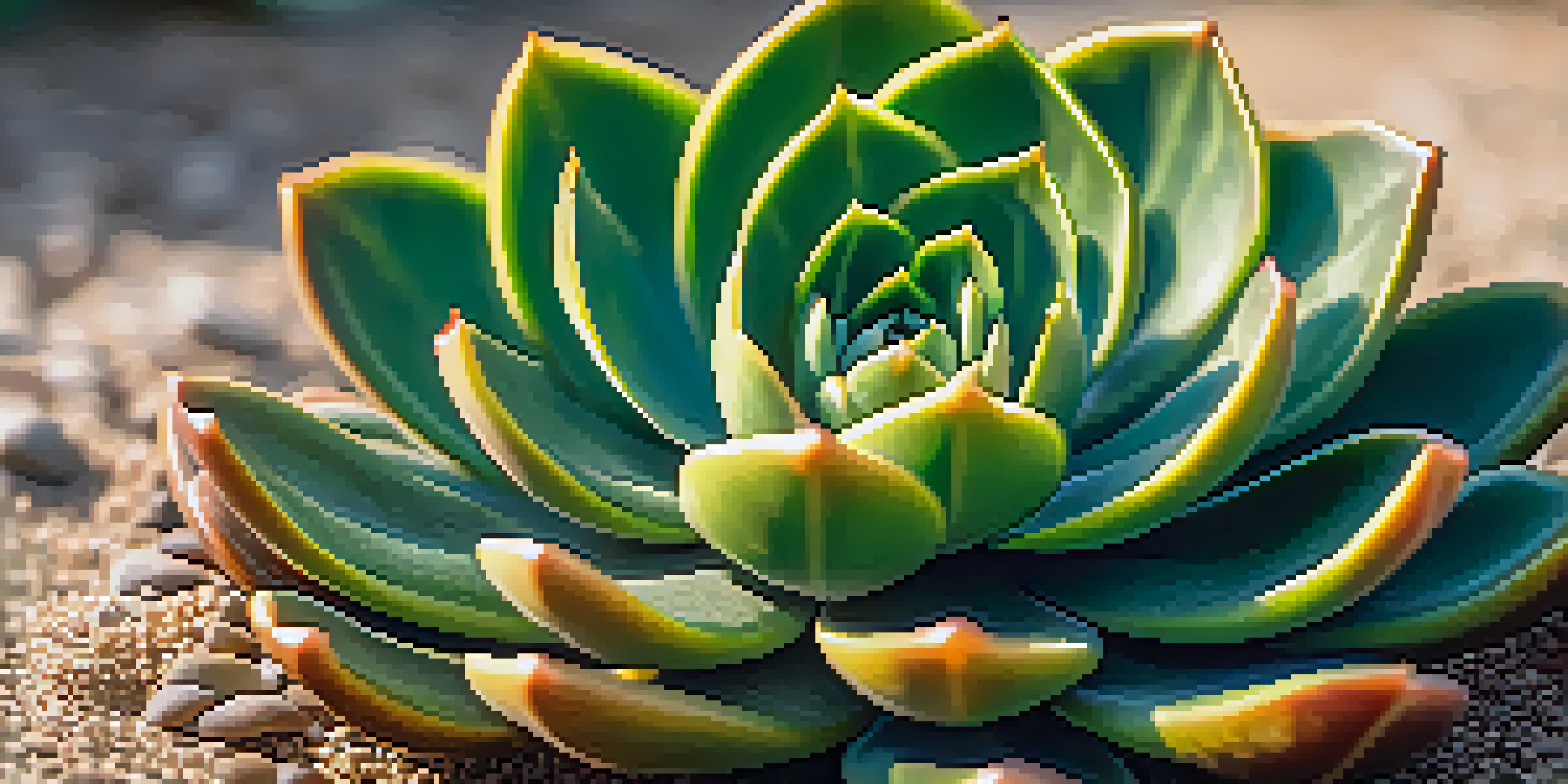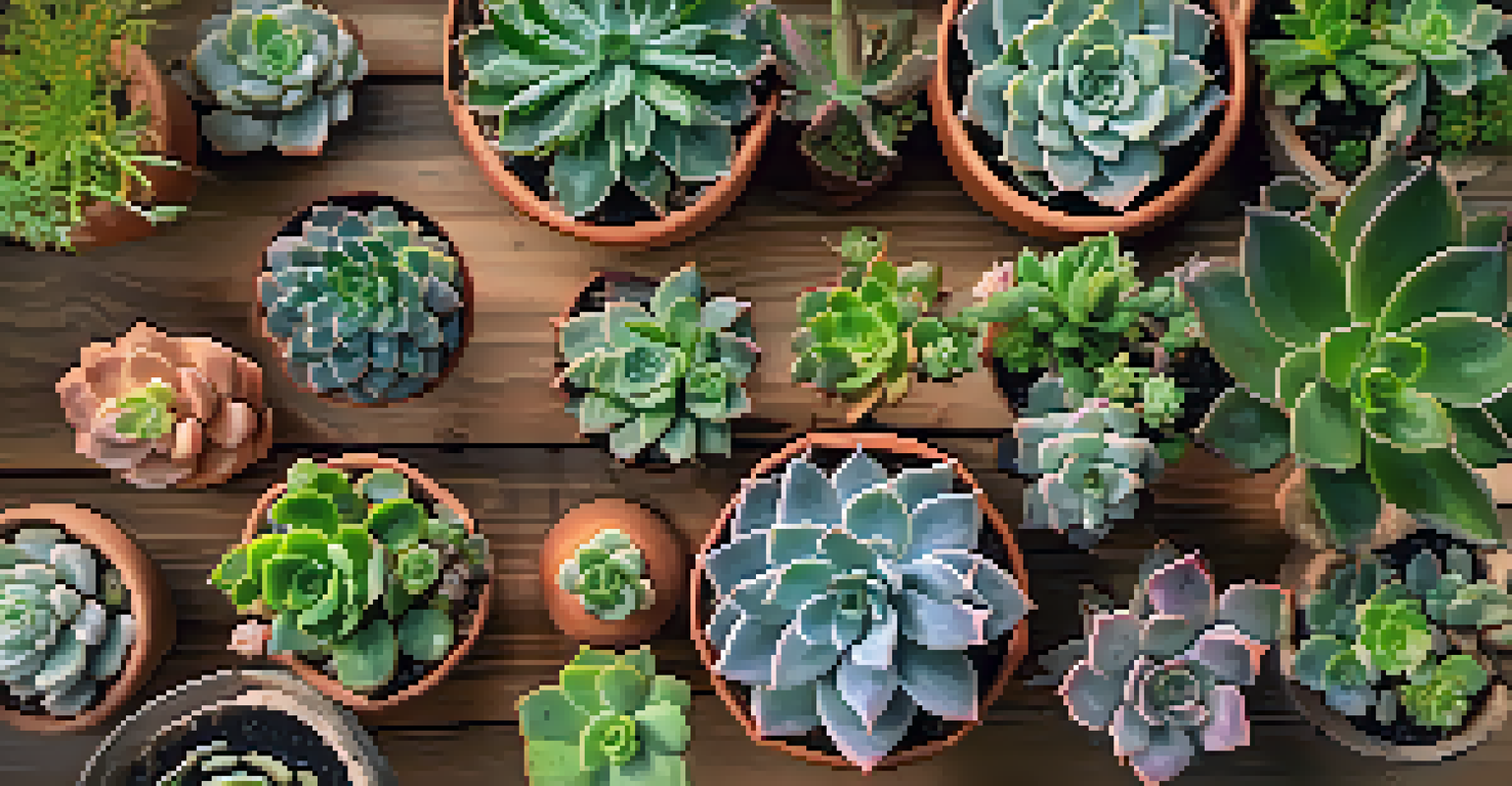How Succulents Store Water: Adaptations for Drought Survival

Introduction: The Resilience of Succulents in Dry Environments
Succulents are remarkable plants known for their ability to thrive in arid conditions. Their unique adaptations not only help them survive but also make them a favorite among gardeners and plant enthusiasts. Understanding how these plants store water can reveal the secrets behind their resilience in drought-prone areas.
The plant that is created to survive in the desert can teach us about resilience and adaptation.
Many people may wonder how these seemingly delicate plants can withstand harsh environments. The key lies in their specialized structures and physiological processes that allow them to conserve water efficiently. By exploring these mechanisms, we can appreciate the beauty and ingenuity of succulents even more.
In this article, we will delve into the various adaptations that enable succulents to store water effectively. From their fleshy leaves to their unique photosynthesis process, we'll uncover the fascinating strategies that keep these plants flourishing against the odds.
Fleshy Leaves: Nature’s Water Reservoirs
One of the most noticeable features of succulents is their thick, fleshy leaves, which serve as reservoirs for water. These leaves can store significant amounts of moisture, allowing the plant to draw from this supply during dry spells. This adaptation is crucial for survival in environments where water is scarce.

The structure of succulent leaves often includes a waxy coating that helps reduce water loss through evaporation. This protective layer acts like a shield, minimizing the amount of moisture escaping into the atmosphere. As temperatures rise, this adaptation becomes even more vital for maintaining hydration.
Succulents Store Water Efficiently
Succulents have specialized structures, such as fleshy leaves and thick stems, that allow them to store significant amounts of water, helping them survive in arid environments.
Additionally, the internal tissue of succulent leaves is designed to hold water efficiently. The cells in these tissues can swell and store water, much like a sponge. This unique characteristic enables succulents to endure long periods without rainfall, making them well-suited for their native habitats.
Stem Storage: A Hidden Water Supply
While many people focus on the leaves of succulents, their stems also play a critical role in water storage. Some succulent species have thick, swollen stems that can hold large quantities of water, serving as a backup reservoir. This adaptation allows the plant to survive extended dry periods when leaf water might be depleted.
In the midst of drought and desolation, the succulent stands as a symbol of perseverance.
The stem's ability to store water is particularly advantageous during the hottest months of the year. When the environment becomes too dry, succulents can rely on their stem's reserves to maintain hydration. This capability is essential for their survival in desert regions where rainfall is infrequent.
In some cases, these stems can even photosynthesize, providing energy while conserving water. By adapting their growth habits and structures, succulents demonstrate the remarkable ways plants can evolve to thrive in challenging conditions.
Photosynthesis: A Water-Saving Strategy
Succulents have developed a unique form of photosynthesis called Crassulacean Acid Metabolism (CAM), which is particularly efficient in water use. Unlike typical photosynthesis that occurs during the day, CAM allows succulents to open their stomata at night to absorb carbon dioxide. This method minimizes water loss, making it ideal for dry climates.
During the day, when temperatures rise, succulents keep their stomata closed to retain moisture. This strategic timing not only conserves water but also enables the plants to continue producing energy through photosynthesis without excessive water loss. It's a brilliant adaptation that highlights their survival skills.
Unique Photosynthesis Method
By utilizing Crassulacean Acid Metabolism (CAM), succulents minimize water loss during photosynthesis by opening their stomata at night.
By utilizing CAM, succulents can thrive in conditions that would be challenging for many other plants. This process allows them to grow and flourish even in the harshest environments, showcasing nature's ability to innovate and adapt.
Root Systems: Anchoring and Accessing Water
The root systems of succulents are another essential adaptation for drought survival. Many succulents have shallow but extensive roots that spread out to capture any available moisture. This allows them to take advantage of even the smallest amounts of rain that may fall in their arid habitats.
Some species, however, have deeper root systems that can tap into underground water sources. This versatility in root structure ensures that succulents can access water at various soil depths, enhancing their chances of survival during prolonged dry spells. It's a clever way of maximizing their water-collecting potential.
By efficiently anchoring themselves in the soil while reaching for moisture, succulents demonstrate a well-balanced strategy for thriving in challenging conditions. Their adaptability in root growth is a testament to their resilience and ingenuity.
Water-Conserving Strategies: A Holistic Approach
In addition to their structural adaptations, succulents employ several water-conserving strategies to enhance their survival. These strategies include shedding leaves during extreme drought conditions, which reduces the surface area responsible for water loss. By sacrificing some foliage, the plant can focus its resources on preserving the remaining water.
Another strategy involves the use of specialized cells called guard cells, which regulate the opening and closing of stomata. This allows succulents to fine-tune their water usage based on environmental conditions. When the air is dry, they can close their stomata to prevent moisture loss, demonstrating their ability to respond to changing circumstances.
Adaptable Root Systems
The root systems of succulents, which can be shallow or deep, enable them to access moisture from various soil depths, enhancing their survival during dry spells.
Collectively, these strategies create a holistic approach to water conservation that is vital for succulents' survival. By combining various methods, these plants can navigate the challenges of their environments and continue to thrive.
Conclusion: The Marvel of Succulent Adaptations
Succulents are a testament to nature's ingenuity, showcasing a remarkable array of adaptations for water storage and drought survival. From their fleshy leaves and thick stems to their unique photosynthesis process, these plants have evolved to thrive in some of the harshest conditions on Earth. Their ability to store water efficiently allows them to endure long dry periods and flourish.
As we explore the world of succulents, we gain a deeper appreciation for their resilience and beauty. Whether you’re a seasoned gardener or a curious beginner, understanding these adaptations can help you care for these unique plants. Embracing their needs will ensure that they continue to thrive in our homes and gardens.

In closing, succulents remind us that even in the most challenging environments, life finds a way to adapt and flourish. By learning from their strategies, we can not only enjoy their beauty but also gain insights into the wonders of nature.